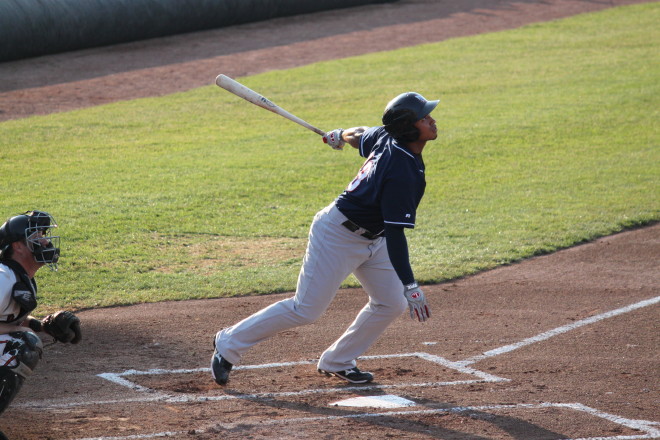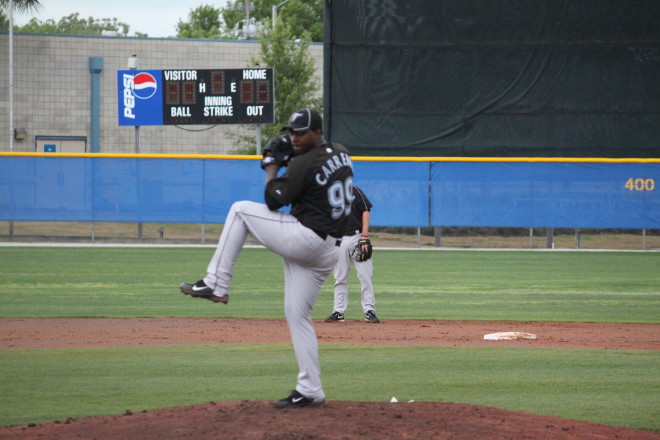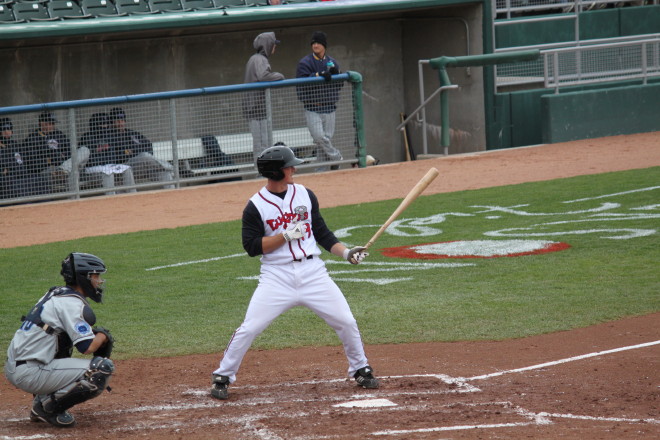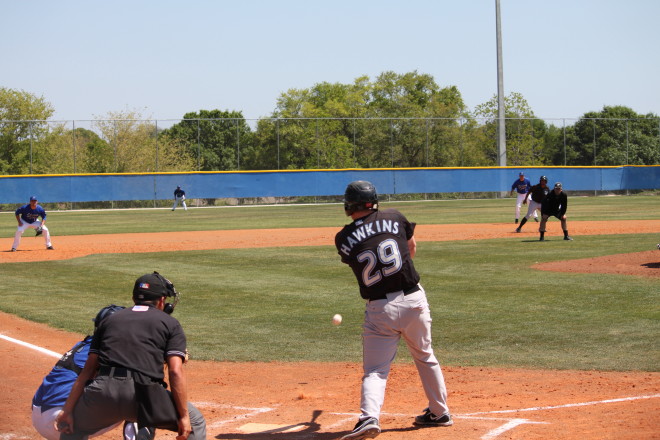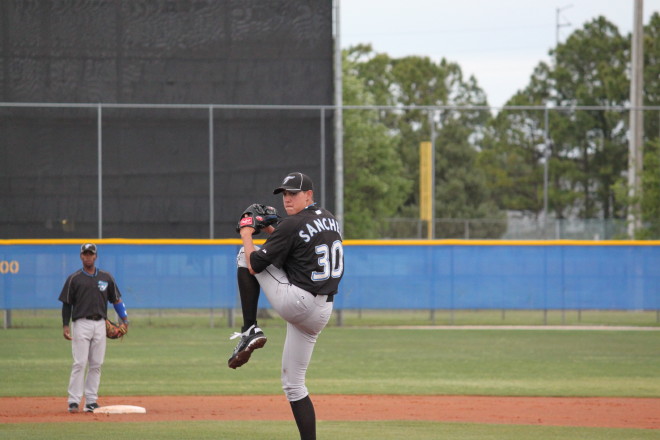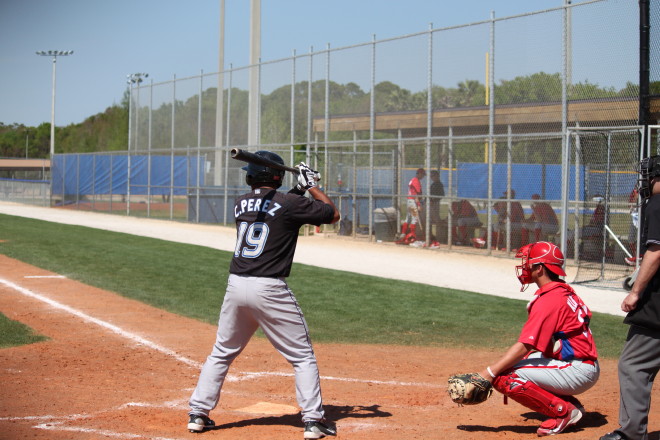20. David Cooper | 1B
| Year | Age | Level | AB | 2B | 3B | HR | BB | K | SB | CS | AVG | OBP | SLG |
| 2008 |
21 |
A- |
85 |
10 |
1 |
2 |
10 |
16 |
0 |
1 |
.341 |
.411 |
.553 |
| 2008 |
21 |
A |
96 |
10 |
0 |
2 |
10 |
14 |
0 |
0 |
.354 |
.415 |
.521 |
| 2008 |
21 |
A+ |
92 |
9 |
0 |
1 |
10 |
16 |
0 |
0 |
.304 |
.373 |
.435 |
| 2009 |
22 |
AA |
473 |
32 |
0 |
10 |
59 |
92 |
0 |
0 |
.258 |
.340 |
.389 |
| 2010 |
23 |
AA |
498 |
30 |
1 |
20 |
52 |
74 |
0 |
0 |
.257 |
.327 |
.442 |
| 2011 |
24 |
AAA |
467 |
51 |
1 |
9 |
67 |
43 |
1 |
3 |
.364 |
.439 |
.535 |
| 2011 |
24 |
MLB |
71 |
7 |
0 |
2 |
7 |
14 |
0 |
0 |
.211 |
.284 |
.394 |
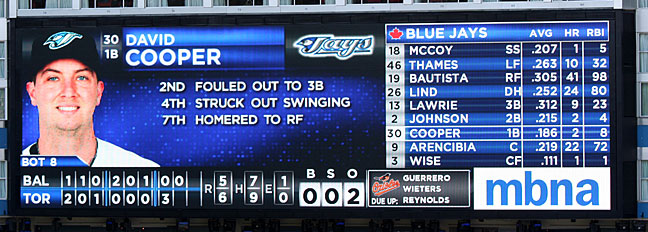
David Cooper is probably the most divisive prospect on our list. With ranks ranging from #3 to #28, the roster doesn't really know what to do with him. Do you believe his fantastic 2011 at Las Vegas, or do you chalk it up to a paradisiacal hitting environment and instead look at his uninspiring AA numbers?
The answer, as always, is somewhere in between. While it's true that Las Vegas makes good hitters look Ruthian, every ballpark has its adjustment factor, and once applied, Cooper still had a very good year. I would point especially to his BB/K ratio (67/43, and significantly better than in past years) and doubles tally (51, second most in the minors, and #1 when you include his seven major league two-baggers).
That said, when it comes down to it, Cooper is just never going to be a star. He's a first baseman who doesn't defend particularly well and doesn't have much home run power, so he pretty much has to do everything else well to even be an average major league first baseman. Realistically he's probably a part-time player who might be able to carve out a major league career if he can hit righties. A lefty bench bat is useful, even one without much positional flexibility, and Cooper could be in the mix for at bats in 2012, especially given Adam Lind's awful second half.
19. Michael Crouse | CF
| Year | Age | Level | AB | 2B | 3B | HR | BB | K | SB | CS | AVG | OBP | SLG |
| 2008 |
17 |
Rk |
15 |
0 |
1 |
0 |
3 |
7 |
1 |
1 |
.133 |
.316 |
.267 |
| 2009 |
18 |
Rk |
214 |
9 |
4 |
2 |
23 |
53 |
25 |
5 |
.218 |
.308 |
.340 |
| 2010 |
19 |
Rk |
107 |
7 |
3 |
4 |
9 |
32 |
9 |
6 |
.333 |
.402 |
.594 |
| 2010 |
19 |
A |
105 |
5 |
2 |
2 |
14 |
35 |
5 |
2 |
.216 |
.327 |
.386 |
| 2011 |
20 |
A |
364 |
26 |
5 |
14 |
44 |
113 |
38 |
8 |
.261 |
.352 |
.475 |
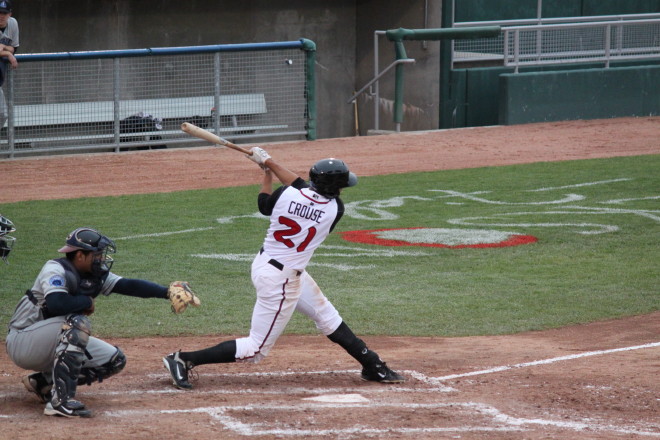
Michael Crouse is a big athletic outfielder from British Columbia whose father played in both the NFL and CFL. Listed at 6'4" and 215 pounds, he could pass for either a baseball player or an NFL tight-end. Crouse also puts that size to good use, as he can hit for average and power, combined with good speed and the ability to play right or centre field. Crouse also has a strong arm, with the total package he could be a five tool player. The Midwest League is a low offense league but Crouse put up an OPS of .827 and stole 38 bases while being caught only 8 times. The average age in the MWL is 22 plus, and Crouse at age 20 was young for the league and to show the power and speed that he did is a very good achievement.
All of that sounds great, and it could be, but the most important tool is the hit for average tool. There, Crouse managed to hit just .261 this season and struck out in more than 30% of his at-bats. Crouse has a max-effort swing, he looks like he is trying to muscle the ball. A shorter, smoother swing would work well for him and help him cut down on the strikeouts.
Crouse is likely headed to Dunedin next season to continue his outfield partnership with Jake Marisnick and Marcus Knecht. He was under-age for the Midwest League and, at 21 in 2012, would be under-age for the Florida State League. If he can generate more contact he could be headed for a nice major league career.
18. Moises Sierra | RF
| Year | Age | Level | AB | 2B | 3B | HR | BB | K | SB | CS | AVG | OBP | SLG |
| 2008 |
20 |
A |
489 |
16 |
5 |
9 |
26 |
114 |
12 |
11 |
.246 |
.297 |
.364 |
| 2009 |
21 |
A+ |
459 |
24 |
2 |
5 |
34 |
66 |
10 |
2 |
.286 |
.360 |
.393 |
| 2009 |
21 |
AA |
36 |
1 |
0 |
1 |
1 |
8 |
0 |
31 |
.353 |
.361 |
..471 |
| 2010 |
22 |
R |
38 |
2 |
0 |
1 |
4 |
8 |
0 |
0 |
.265 |
.342 |
.412 |
| 2010 |
22 |
A+ |
40 |
1 |
0 |
1 |
1 |
11 |
0 |
1 |
.162 |
.175 |
.270 |
| 2011 |
23 |
AA |
551 |
19 |
3 |
18 |
39 |
93 |
16 |
14 |
.277 |
.342 |
.436 |
Moises has been battling injuries in the recent years in the Blue Jays organization, but in 2011 he broke away from his past maladies and put in a good year at double A ball with a .277 average and a .778 OPS, a decent performance in a relatively pitcher-friendly league. He led New Hampshire with 18 home runs and had a 93 K to 39 BB ratio in 551 PA, posting the best isolated power and second best strike out marks of his career. Sierra is an okay defender in right, though of course we cannot forget his plus, plus, arm, which profiles as the best in the system.
Sierra could head for Las Vegas in 2012 and, if he can refine his approach, look for Moises get a crack at a crowded Blue Jays outfield in the future.
17. Adonys Cardona | RHP
| Year | Age | Level | G | GS | IP | H/9 | HR/9 | BB/9 | K/9 | ERA |
| 2011 |
17 |
Rk |
10 |
7 |
31.2 |
8.8 |
0.6 |
3.4 |
9.9 |
4.55 |
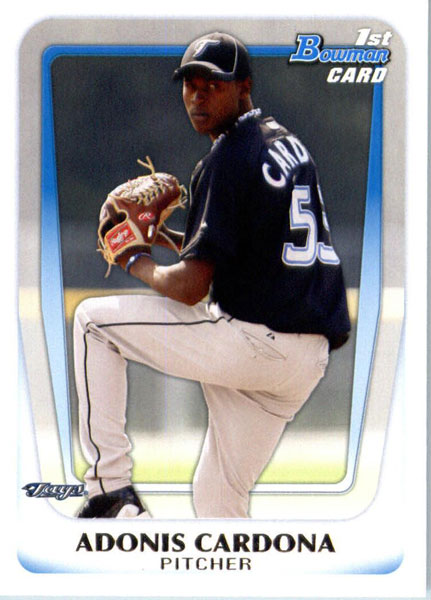
The 17 year-old Venezuelan righty came into 2011 as the #19 prospect in the Jays farm system according to Baseball America. Cardona was given a $2.8 million signing bonus, the highest ever given to a Venezuelan amateur. Instead of making his pro debut in the Dominican Summer League, he made it in the Gulf Coast League this summer and out duelled Luis Heredia, the Pirates top international signing, with three shutout innings of one-hit ball while striking out four June 21. That no-decision was followed by two straight losses, as he allowed six runs over five innings. His first and lone professional win came in relief against the Braves July 9 by scattering two hits and a walk over three innings while racking up three strikeouts.
His ERA was 6.75 in June and 5.28 in July but he turned a corner in August with a 2.45 mark. He enjoyed pitching in Dunedin with a 2.55 ERA but his road mark was 7.07. More positives about Cardona’s season were a 3.14 FIP (Fielding Independent Pitching) and an ISO (Isolated Power) against mark of .083.
Initial scouting reports had Cardona’s fastball in the 88-91 mph range, touching 93. There was word he was pumping gas as high as 94-95 over the summer. With a long, lean frame of 6-4, 175 pounds, Cardona could add another tick or two to his heater which has the potential to be a plus pitch. His changeup is said to be advanced with some sink but he needs to work on his curveball. Concerns have also been expressed about his delivery. Cardona, who turns 18 January 16, was recently rated as the #8 prospect in the Gulf Coast League by Baseball America.
16. Joel Carreno | RHP
| Year | Age | Level | G | GS | IP | H/9 | HR/9 | BB/9 | K/9 | ERA |
| 2008 | 21 | A- | 15 | 13 | 76.1 | 8.75 | 0.71 | 2.24 | 10.02 | 3.42 |
| 2009 | 22 | A- |
2 |
2 | 11.0 | 4.91 | 0.00 | 2.45 | 9.82 | 0.82 |
| 2009 | 22 | A | 14 | 14 | 79.2 | 8.64 | 0.56 | 3.28 | 7.00 | 3.62 |
| 2010 | 23 | A+ | 27 | 25 | 137.2 | 9.64 | 0.52 | 1.96 | 11.31 | 3.73 |
| 2011 | 24 | AA | 24 | 23 | 134.2 | 6.68 | 0.80 | 4.54 | 10.16 | 3.41 |
| 2011 | 24 | MLB | 11 | 0 | 15.2 | 6.31 | 0.58 | 2.30 | 8.04 | 1.15 |
Somewhat randomly (or not) Joel Carreno ends up in the exact same spot he was on this list in 2010. Normally that might be seen as a bad thing, but given the remarkably talent the Jays are accumulating in their system, holding steady shouldn't be considered a step back. Carreno actually had a good 2011, moving up a level to New Hampshire and putting in a solid season's worth of work. He didn't quite match his ridiculous K-rates of 2010, and what had been to that point excellent control deserted him as he walked a batter every two innings. Offsetting this though was a remarkable drop in his rate of hits allowed, helped out by a 100 point drop in BABIP against, to a more reasonable .276. As a result Carreno was pretty unhittable, and also succeeded in keeping the ball on the ground, a big plus. A brief relief stint with the Jays to end the year was also a success, as he allowed only 2 runs in 15.2 innings with good peripherals.
Carreno throws in the low 90s and relies heavily on a wicked 80 MPH slider (that Fangraphs misclassifies as a curve), mixing in the occasional change up, which he will have to improve on. If he can continue to keep the ball on the ground and limit his walks, his strong fastball/slider combination should allow Carreno to stick in the majors for a while. However his 2 pitches and lack of status in the Jays organization probable portends to a future in the bullpen, limiting Carreno's future value, for prospect list purposes anyway. There is a chance that he could compete for a rotation spot coming out of spring training, but odds are he'll begin 2012 as part of a refurbished Jays bullpen.
15. Marcus Knecht | LF
| Year | Age | Level | AB | 2B | 3B | HR | BB | K | SB | CS | AVG | OBP | SLG |
| 2010 |
20 |
A- |
231 |
18 |
3 |
5 |
26 |
48 |
7 |
1 |
.268 |
.345 |
.437 |
| 2011 |
21 |
A+ |
439 |
34 |
3 |
16 |
67 |
124 |
4 |
3 |
.273 |
.377 |
.474 |
A 3rd round pick in the 2010 draft, North York’s Marcus Knecht was perhaps the centerpiece of Lansing’s strong outfield in 2011. Originally drafted by the Brewers in the 23rd round in 2008, Knecht chose to attend Oklahoma State instead. He didn’t play regularly for the Sooners, receiving only 12 plate appearances, and transferred to Connors State for the 2010 season, hitting .353. Knecht, who had won the Hit-Run-Throw program as an 11-year-old, also had connections to Andrew Tinnish through the Ontario Blue Jays and the Jays didn’t hesitate to select him when he was still on the board in the 3rd round.
Knecht had an even better offensive season this year than he did in 2010. In 2011, Knecht jumped to Lansing and hit .273/.377/.474 for an .851 OPS against a .782 OPS in 2010. At 21, Knecht was at an appropriate level for his age. Knecht’s OPS ranked second among Lansing regulars, behind only Jake Marisnick, and he led the team in many offensive categories, such as doubles, homers, RBI and walks. Knecht also demonstrated some offensive capabilities that don’t show up in the obvious stats, as he was second on the team with 12 hit-by-pitches and led the team in sacrifice flies with ten (Carlos Perez was the only other batter with at least five). Additionally, Knecht only grounded into four double plays in 528 plate appearances.
One of Knecht’s major weaknesses is that he has a below-average arm and it was suggested in college scouting reports that he would be limited to left field if he were to make the majors. Although he played more right field than left for the Doubledays, he made the transition to left field this year, appearing in over 100 of his 111 games in left field for the Lugnuts.
Prior to the draft, scouting reports suggested that Knecht had good bat speed, although his swing was unorthodox and could look awkward. It was also suggested Knecht could get over-aggressive at the plate, but his stats this year don’t suggest he had that problem regularly this year. Knecht will probably begin 2012 in Dunedin and will progress as far as his bat takes him.
14. Chris Hawkins | LF
| Year | Age | Level | AB | 2B | 3B | HR | BB | K | SB | CS | AVG | OBP | SLG |
| 2010 |
18 |
RK |
157 |
9 |
3 |
0 |
15 |
38 |
8 |
3 |
.255 |
.324 |
.350 |
| 2011 |
19 |
A+ |
4 |
0 |
0 |
0 |
0 |
2 |
0 |
0 |
.000 |
.000 |
.000 |
| 2011 |
19 |
RK+ |
242 |
15 |
6 |
5 |
22 |
46 |
14 |
4 |
.318 |
.375 |
.492 |
The Toronto Blue Jays organization will likely continue to reap the rewards of the 2010 draft for years to come. This well-above-average draft class is mostly known for the pitching prospects that it bestowed upon the organization but a number of exciting offensive players were also acquired, led by Hawkins. A Georgia native, other teams' scouts are already starting to take notice and he was ranked as the 11th best prospect in the advanced-rookie Appalachian League in 2011. Hawkins, who recently turned 20, hit .318/.375/.492 in 269 plate appearances. Although he was a little over-aggressive at times, which is not usual for a young hitter, the left-handed hitter still walked at a decent rate (8.2 BB%). For a blossoming power hitter (.174 Isolated Power rate), Hawkins also controlled his strikeout rate (17.1 K%) reasonably well. He destroyed left-handed pitchers with an OPS of .996 (compared to .823 vs RHPs). The biggest knock on Hawkins would be the questions surrounding his glove. Originally a shortstop in high school, he's also played third base and left field in pro ball. At '6'2'' and 195 lbs, he runs well for his size (14 steals in 18 tries) but his average arm strength will probably limit him to left field as he rises through the minor league system. After two years in short-season ball, Hawkins is ready for the Midwest League and should spend the entire year with Lansing - similar to the approach that the organization took with the likes of Jake Marisnick, Michael Crouse, and Marcus Knecht in 2011.
13. Aaron Sanchez | RHP
| Year | Age | Level | G | GS | IP | H/9 | HR/9 | BB/9 | K/9 | ERA |
| 2010 |
18 |
RK |
10 |
10 |
25.0 |
8.3 |
0.4 |
6.1 |
13.3 |
2.16 |
| 2011 |
19 |
RK |
14 |
9 |
54.1 |
8.8 |
0.7 |
4.3 |
9.3 |
5.30 |
Sanchez entered the 2011 season as perhaps the most heralded of the Jays 2010 high school pitching draftees. Since then he has been eclipsed by Noah Syndergaard and Justin Nicolino. That said, Sanchez remains an exciting prospect, though one with a few warts. Sanchez was susceptible to the big inning in 2011, running up pitch counts and his ERA as his control abandoned him. On the flip side, he showed the ability to strike out more than a batter an inning and improved as his year progressed prior to a late season promotion to Vancouver.
Sanchez's upside is higher than most. He reaches the mid-to-upper 90s with his fastball and features a potential plus curve. If he can harness his control, he has the ability to skyrocket up the prospect charts in 2012. Sanchez will likely remain in Vancouver for short season ball.
12. Carlos Perez | C
| Year | Age | Level | AB | 2B | 3B | HR | BB | K | SB | CS | AVG | OBP | SLG |
| 2008 |
17 |
DSL |
196 |
10 |
2 |
0 |
52 |
28 |
7 |
5 |
.306 |
.459 |
.378 |
| 2009 |
18 |
RK |
141 |
11 |
3 |
1 |
16 |
23 |
2 |
5 |
.291 |
.364 |
.433 |
| 2010 |
19 |
A- |
235 |
11 |
8 |
2 |
34 |
41 |
7 |
3 |
.298 |
.396 |
.438 |
| 2011 |
20 |
A |
383 |
17 |
6 |
3 |
37 |
74 |
6 |
2 |
.256 |
.320 |
.355 |
Carlos Perez’s steak of three consecutive R. Howard Webster Awards came to an end and he’ll spend 2012 trying to set the club record by winning his fourth trophy. More importantly, Perez was unfortunately one of the few highly regarded prospects in Toronto’s system to have a disappointing year. Named the best prospect in the NY-Penn League by Baseball America last year, Perez saw both his OBP and slugging percentage drop by over 75 points in 2011 upon his promotion to the Midwest League.
Of the 10 Lugnuts with at least 250 at-bats, Perez ranked 8th in OBP, ahead of only Bryson Namba and Garis Pena, and 5th in slugging percentage. At 20, he was slightly young for the level, but teammates Jake Marisnick and Michael Crouse both had good offensive seasons at the plate at the same age. This was Perez’s busiest year, playing 95 games at catcher, 29 more than he did the previous season. It’s very possible that Perez tired with the heavy workload as the year progressed, but you have to really squint at the stats to find evidence of that. His OPS in the first half was .689 and it fell 40 points in the second half. He hit well in April, but got progressively worse in May and June, before rebounding in July and then slumping in August again. I don’t know if this is the continuation of an ongoing problem or a potential new trend, but Perez struggled against southpaws to the tune of a .561 OPS and had only four extra-base hits, all doubles, in 119 at-bats against lefties.
Perez’s defence has received accolades from nearly everyone who sees him behind the plate. He is a good defensive catcher, possessing soft hands, quick reflexes and the ability to block pitches in the dirt. Reportedly, Perez calls a very good game and is nearly always in sync with his pitchers. His arm was also described as average but accurate and he possesses a quick release. However, there are some warning signs in his defensive statistics, as he threw out 49% of base runners in 2009, 36% at Auburn in 2010 and then 29% in 2011. Furthermore, the opposition attempted more stolen bases against Lansing than any other team in the Midwest League. Twenty-five more steals were attempted against Lansing than any other team, which is more than the difference that separates the second ranked team from the ninth. Also, runners attempted to steal with about the same degree of frequency against Perez as against backup Jack Murphy (1.68 attempts per game and 1.69 attempts, respectively).
This probably sounds too negative. Remember, in his previous three years Perez won the R. Howard Webster Award at each level he was at. In 2010, as a 19-year-old, he had the second-highest OPS for the Doubledays, ahead of a group of older players including Marcus Knecht. At 18, he led all regulars for the GCL Blue Jays in OPS. He’s an athletic, well-regarded defensive catcher who has demonstrated a good approach at the plate, including the ability to use hit to all fields, a strong batting eye and gap power. There’s still a lot to be excited about here.
11. A.J. Jimenez | C
| Year | Age | Level | AB | 2B | 3B | HR | BB | K | SB | CS | AVG | OBP | SLG |
| 2008 |
18 |
RK |
47 |
2 |
0 |
0 |
3 |
16 |
5 |
2 |
.191 |
.255 |
.234 |
| 2009 |
19 |
A |
278 |
15 |
1 |
3 |
7 |
72 |
5 |
2 |
.263 |
.280 |
.356 |
| 2010 |
20 |
A |
262 |
22 |
0 |
4 |
18 |
56 |
17 |
4 |
.305 |
.347 |
.435 |
| 2010 |
20 |
A+ |
9 |
0 |
0 |
1 |
0 |
5 |
0 |
0 |
.111 |
.111 |
.444 |
| 2011 |
21 |
A+ |
379 |
29 |
1 |
4 |
28 |
60 |
11 |
2 |
.303 |
.353 |
.417 |
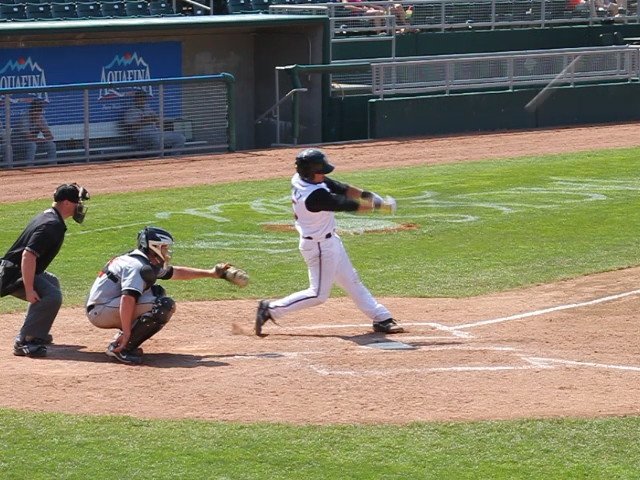
A.J. Jimenez's numbers won't blow you away upon first glance, but his ranking here is based on two other factors he has going for him: the fact that he's a catcher, and a good defensive one at that, and his age-relative-to-league. Take a look at the following two FSL lines:
Age 20.9, 379 AB: .303/.353/.417
Age 21.2, 263 AB: .259/.315/.411
I'm sure most of you figured out that the first line is Jimenez this season while the second is Travis d'Arnaud last season. Obviously nobody's arguing that Jimenez is nearly as good a prospect as d'Arnaud, but d'Arnaud's breakout is a testament to the importance of considering age-relative-to-league. A prospect who succeeds at a young age compared to his peers is more likely to break out and become a top prospect, as was the case with d'Arnaud, and while it's not the most likely scenario for Jimenez, it shouldn't come as a huge surprise if he continues to improve as he moves up the ladder.
Of course, no prospect is perfect. As a hitter, A.J. hits for average and doesn't strike out a ton but we'd like to see him draw a few more walks and hit for more power. Jimenez is one to keep a close eye on in 2012.




